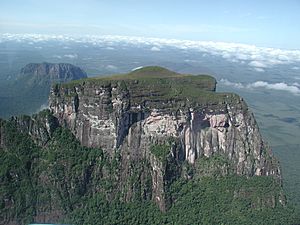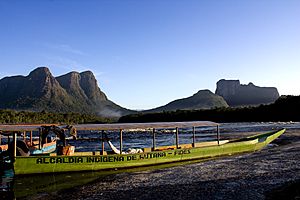Cerro Autana facts for kids
Cerro Autana is a very special mountain in Venezuela. It's located in the Amazonas state, close to the border with Colombia. This mountain looks unique because it has a narrow base, a flat top, and super steep sides. It stands about 1,220 meters (4,000 feet) tall!
Cerro Autana is a type of mountain called a tepui. Tepuis are flat-topped mountains found in the Guiana Shield region. For the Piaroa people, who live nearby, Cerro Autana is a sacred place. They call it Wahari-Kuawai and believe it's the "tree of life" from their ancient stories.
The first Europeans to explore this area were Humboldt and Bonpland in 1800. Later, in the 1850s, Richard Spruce and Alfred Russel Wallace studied the plants here. Cerro Autana is so important that it was made a Natural Monument in 1978. This protected area also includes part of the Autana River and Lake Leopoldo. The mountain is also famous for big wall climbing and exciting BASE jumping.
Contents
Exploring Cerro Autana's Unique Features
Cerro Autana is like a leftover piece of a huge sandstone plateau. This plateau once covered a large area between the Amazon and Orinoco rivers. Over time, water slowly wore away the rock. It dissolved the natural "glue" holding the sandstone together. This caused big blocks of rock to break off, forming the steep walls we see today.
Water also created amazing cave systems inside the mountain. These caves are rare because they formed in sandstone, not the usual limestone. The sandstone here has special parts with calcium carbonate. When water dissolves this, it leaves huge empty spaces.
Inside Cerro Autana, there are interconnected caverns and a large room with a domed ceiling. This "living room" has two openings that go right through the mountain. One opening is like a balcony on the vertical wall. Some parts of these caves have collapsed recently. A unique mineral called sveite was found here. It's named after the Venezuelan Speleology Society.
Adventures on Autana
The caves of Cerro Autana were first explored in 1970 by Charles Brewer-Carías and David Nott. They landed on the top by helicopter and used ropes to go down into the caves. The mountain was first climbed in 1974 by Stephen Platt, David Nott, Wilmer Perez, and Carlos Reyes. They climbed the 600-meter (2,000-foot) North Ridge. The climb took three days! They then spent four days mapping the caves before climbing back down. In 1985, a team of skydivers even jumped onto the summit for a documentary!
Plants and Animals of Cerro Autana
Just like other tepui mountains, Cerro Autana has special plants. The open rock surfaces are home to algae, lichens, mosses, and small plants. The steep walls are covered with bromeliads, which are plants that often grow on other plants.
The top of the mountain is mostly open grassland, like a savanna. But there are also small forests with trees that are 2.5 to 10 meters (8 to 33 feet) tall. Even though the summit isn't huge, it has many different habitats and tiny climates.
Only two types of amphibians are known to live on the summit. One is Leptodactylus lithonaetes. The other, Stefania breweri, is very special because it's only found on Cerro Autana! Only one of these frogs has ever been seen, back in 1971.
The Sacred Tree of Life: A Piaroa Story
For the Piaroa people, Cerro Autana is a very sacred mountain. They call it Wahari-Kuawai, which means the stump of 'the sacred tree of the fruits of the world'.
Their old stories say that this tree was so tall it reached the sky. Its branches were full of fruits that fell and gave life to the whole Amazon region. One day, Wahari (a god) and his nephew Ruayei, who had turned into a lapa (a type of rodent), decided to cut down the tree. They wanted all the fruits at once! Ruayei gnawed at the base until the tree fell.
When the tree fell, its branches created the forests of the Cuao River to the north. The branches that fell to the west formed the mountains of Sipapo, Waichij, and Uripikai. The falling tree also changed the path of rivers and created a lake (Autana/Leopoldo) on top of the mountains east of Autana.
In one of the rivers, a payara fish got trapped. This fish tried to escape by leaping higher and higher. Each time it jumped, it hit the stump of the Wahari-Kuawai (Cerro Autana), forming the caves inside the mountain. Finally, the payara fish jumped right through the mountain, creating the Great Cave, also called the Payara Inlet. After that, it leaped free into the Umaj-Ajé River.
See also
 In Spanish: Cerro Autana para niños
In Spanish: Cerro Autana para niños




